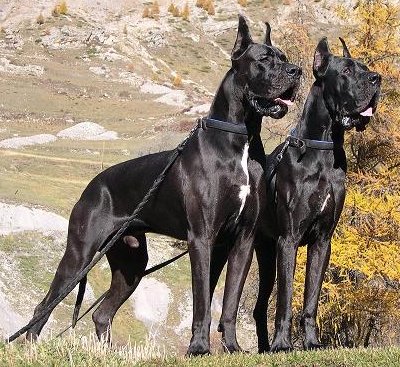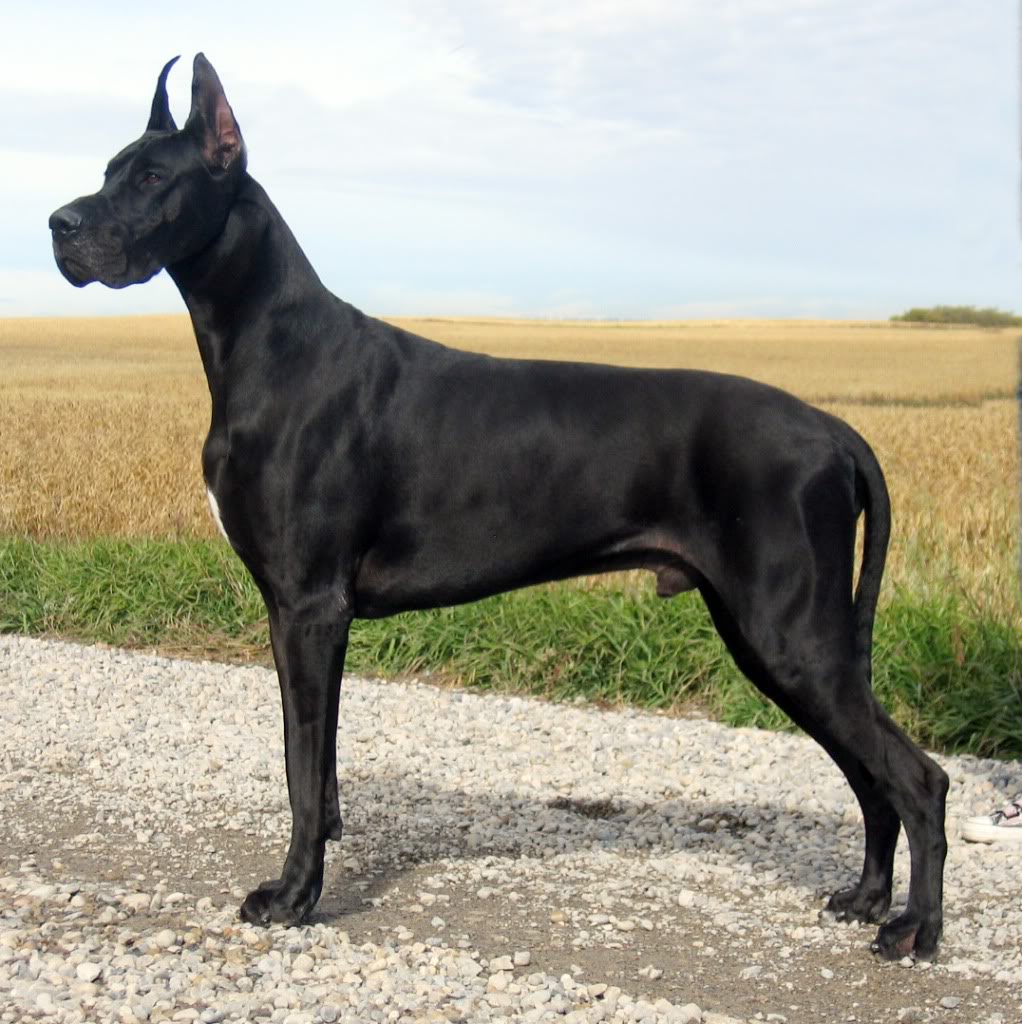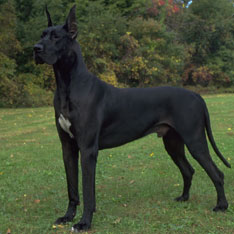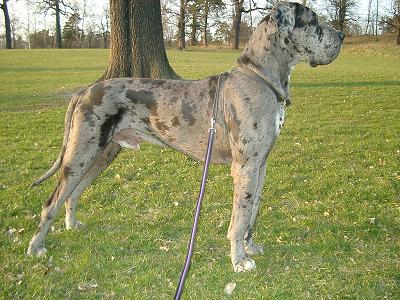
The Breed History
The name "Great Dane" originates in the French language; the
meaning is "Big Danish". Proudly termed "King of Dogs", "Gentle
Giant" or "Apollo of Dogs" by breed fanciers, this was actually a
breed originating in Germany, so it is unclear how it became named
"Dane". The Tibetan Mastiff is thought to be a direct ancestor of the
Great Dane. Also linked to breed development is the Alaunt from
Asian Russia, the English Mastiff and the Irish Wolfhound. Other
reports place Greyhound in the mix later in the breed development,
a step that may have greatly refined the mastiff type. Distinct Great
Dane lineage can be traced back about 400 years. In a meeting
that took place about 1880, a resolution was passed to name this
breed "Deutsche Dogge" which translates roughly as "German
Mastiff," and at that time, it was decreed that the breed name Great
Dane should not be applied to this breed, but in spite of this, the
name persists today in English-speaking countries. The first breed
standard was adopted in 1891.
Breeding for Function
In Germany this breed excelled at wild boar hunting. Because it
took great power, courage, and stamina to hunt boar, the focus of
breeding programs was to produce a large, courageous, powerful,
agile and very fast dog. They were also used as war dogs. Guarding
of estates and carriages was also a task the Great Dane excelled at.
These days, most dogs are companion dogs.
Physical Characteristics
Height at Withers: female minimum 28" (71 cm), but ideally, 30"
(76 cm) or more. Male: minimum is 30" (cm), the ideal is over 32"
(81 cm).
Weight: 100-120 lb (45.5-55 kg).
Coat: The very short, thick and glossy coat is accepted in the
following colors: Fawn (yellow-gold with black mask), brindle
(yellow-gold base with well defined black stripes and usually black
masked), blue (steel blue), black, and harlequin (white base with
medium-sized irregular patches of black over the haircoat).
Longevity: 7-9 years
Points of Conformation: These dogs possess a large well chiseled
head with a flat skull, and the head is rectangular in outline, with a
pronounced stop. The nose is ridged but not split. The conformation
is well balanced; the build is heavier in males, both in bone and
musculature. The gait is a straight, low, elastic long and powerful
ground-covering stride. The almond-shaped eyes are usually darkly
pigmented, medium-sized and deep-set and the palpebral margins
do not evert. Ears are medium sized, high-set and the leather is
moderately thick. The folded ears rest close to the cheeks. Ears are
sometimes cropped to stay pricked in North America. The nose is
large and pigmented black or close to black except in harlequins
where a spotted nose is allowed. The neck is long and free of
dewlaps, arched, and the topline is short and level. The thorax is
very deep and broad, and ribs are well sprung. Abdomen tuck up is
pronounced. The tail is set high, is thick at the base, then tapers to
reach to the tarsus; is carried level during movement and low when
at rest. Limbs are long and straight boned, feet are compact and
well knuckled, and dewclaw removal is optional.
Recognized Behavior Issues and Traits
Reported breed characteristics include: Courageous in the hunt, but
friendly and gentle in the home—even playful. Good with children,
easy to groom, clean but needs lots of space to exercise in a fenced
area. Not suitable for an apartment or small homes. Fairly good
trainability, some are aggressive with other dogs unless they know
them, early obedience training is important, they possess average
activity levels, and have moderate to high exercise needs. This is
a late maturing breed. Some Great Danes can be shy and people
aggressive.
Normal Physiologic Variations
Merle Coat Color: Caused by a dominant mutation in the SILV
gene. Breeding two merle dogs together should be avoided, as
homozygous dogs can be born with multiple defects, including
blindness, deafness, and heart anomalies.1
Harlequin Coat Color: Due the combined action of a dominant
gene H with the merle gene M in the genotype HhM+. The H gene is
a prenatal lethal when homozygous HH, so all Harlequin Danes are
heterozygous Hh.
Echocardiographic Normal Values:
Parameter 90% Confidence Interval
AO (cm) - 2.8-3.4
AOexc (cm) - 0.6-1.3
LA (cm) - 2.8-4.6
LA/AO - 0.9-1.5
LVd (cm) - 4.4-5.9
LVs (cm) - 3.4-4.5
%FS - 18-36
%EF - 33-65
LVET (sec) - 0.12-0.18
Vcf (cir/sec) - 1.0-2.3
EPSS (cm) - 0.5-1.2
VSd (cm) - 1.2-1.6
VSs (cm) - 1.4-1.9
VS% - 6-32
VSexc (cm) - 0.2-0.8
LVWd (cm) - 1.0-1.6
LVWs (cm) - 1.1-1.9
LVW% -9-29
LVWexc (cm) - 0.9-1.5
HR - 100-130
Kg - 52-75
N - 15
AO, aorta; LA, left atrium; LV, left ventricle; FS, fractional shortening;
EF, ejection fraction; LVET, left ventricular ejection time; Vcf,
velocity of circumferential; EPSS, E-point to septal separation; VS,
ventricular septum; VS%Δ, change in VS thickness between diastole
and systole; LVW, left ventricular wall; HR, heart rate; N, number of
animals.
Drug Sensitivities
None reported
Inherited Diseases
Hip Dysplasia: Polygenically inherited trait causing degenerative
joint disease and hip arthritis. OFA reports 12.0% affected.
Dilated Cardiomyopathy (DCM): Affected dogs have reduced
shortening fraction (FS) in the presence of clinical and radiographic
signs of left-sided or biventricular heart failure. Atrial fibrillation
is the most common arrhythmia. Some affected Great Danes may
be asymptomatic, with ECHO or Doppler necessary to make the
diagnosis. Molecular genetic studies show changes in calstabin and
triad in gene expression. Pedigree analysis suggests that DCM in the
breed involves a major X-linked recessive gene, although polygenic
inheritance cannot be ruled out. Reported at a frequency of 5% in
the Great Dane Club Of America National Health Survey.
Elbow Dysplasia: Polygenically inherited trait causing elbow
arthritis. OFA reports 3.8% affected.
Patella Luxation: Polygenically inherited laxity of patellar ligaments,
causing luxation, lameness, and later degenerative joint disease.
Treat surgically if causing clinical signs. OFA reports 1.4% affected.
Disease Predispositions
Gastric Dilation/Volvulus (GDV, Bloat): Life-threatening twisting
of the stomach within the abdomen. Requires immediate veterinary
attention. There is a 42.4% lifetime risk of developing GDV in Great
Danes, with 9.2% of all Great Danes dying from the condition. Risk
of death from GDV after prophylactic gastropexy decreased 29.6x
fold. Dorn reports a 43.23x odds ratio versus other breeds. Bloat with
torsion is reported at a frequency of 11%, and without torsion at 4%
in the Great Dane Club Of America National Health Survey.
Hypothyroidism: Inherited autoimmune thyroiditis. 10.1% positive
for thyroid auto-antibodies based on testing at Michigan State
University. (Ave. for all breeds is 7.5%) Reported at a frequency of 5%
in the Great Dane Club Of America National Health Survey.
Allergic Dermatitis: Inhalant or food allergy. Presents with pruritis
and pyotraumatic dermatitis. Reported at a frequency of 10% in the
Great Dane Club Of America National Health Survey.
Cataracts: Anterior cortex, posterior cortex, equatorial intermediate
and punctate cataracts predominate in the breed. Identified in
6.93% of Great Danes CERF-examined by veterinary ophthalmologists
between 2000-2005. Reported at a frequency of 3% in the
Great Dane Club Of America National Health Survey. CERF does not
recommend breeding any Great Dane with a cataract.
Panosteitis: Self-limiting disease of young, large breed dogs involving
the diaphyseal and metaphyseal areas of the tubular long bones.
Affected dogs show intermittent lameness. Reported at a frequency
of 5% in the Great Dane Club Of America National Health Survey.
Ectropion: Rolling out of eyelids, often with a medial canthal pocket.
Can cause secondary conjunctivitis. Reported in 4.87% of Great Danes
CERF-examined by veterinary ophthalmologists between 2000-2005.
Reported at a frequency of 4% in the Great Dane Club Of America
National Health Survey.
Distichiasis: Abnormally placed eyelashes that irritate the cornea and
conjunctiva. Can cause secondary corneal ulceration. Identified in
4.50% of Great Danes CERF-examined by veterinary ophthalmologists
between 2000-2005.
Eury/Macroblepharon: An exceptionally large palpebral fissure. With
laxity, may lead to lower lid ectropion and upper lid entropion. Either
of these conditions may lead to severe ocular irritation. Identified in
4.50% of Great Danes CERF-examined by veterinary ophthalmologists
between 2000-2005.
Demodicosis (Generalized): Dorn reports a 1.79x odds ratio for
developing demodectic mange versus other breeds. This disorder has
an underlying immunodeficiency in its pathogenesis. Reported at a
frequency of 4% in the Great Dane Club Of America National Health
Survey.
Osteosarcoma (OSA): Great Danes are a breed with a predisposition
(5x Odds Ratio) for developing malignant osteosarcoma versus other
breeds. One study showed a prevalence of 4.4%, and an Odds Ratio
of 12.0x versus other breeds. Forelimb OSA was more frequent than
hindlimb OSA in Great Danes. Reported at a frequency of 3% in the
Great Dane Club Of America National Health Survey.
Entropion: Rolling in of eyelids, often causing corneal irritation
or ulceration. Entropion is reported in 2.31% of Great Danes
CERF-examined by veterinary ophthalmologists between 2000-2005.
Reported at a frequency of 3% in the Great Dane Club Of America
National Health Survey.
Cervical Vertebral Instability (Wobbler Syndrome): Vertebral
disorder causing spinal cord compression and ataxia. Radiographic
examinations suggest that the primary lesion is foramenal stenosis
and intervertebral instability at C6-7. Reported at a frequency of 2%
in the Great Dane Club Of America National Health Survey.
Osteochondritis Dissecans (OCD): Abnormality of cartilage
development causing lameness in the shoulder, elbow, hock or stifle.
Severe cases may require surgery. Dorn reports a 22.26x odds ratio
versus other breeds. Reported 87.0x odds ratio for elbow OCD, 32.8x
odds ratio for shoulder OCD, and 309.4x odds ratio for stifle OCD
versus other breeds. Reported at a frequency of 2% in the Great Dane
Club Of America National Health Survey.
Hypertrophic Osteodystrophy (HOD): Immune-mediated disorder
causing fever, and painful, swollen joints and bones in young Great
Danes. Occurs mostly within 3-14 days post-vaccination. Age of onset
is 8-16 weeks. Unknown mode of inheritance. Reported 189.8x odds
ratio versus other breeds. Reported at a frequency of 2% in the Great
Dane Club Of America National Health Survey.
Persistent Pupillary Membranes: Strands of fetal remnant
connecting; iris to iris, cornea, lens, or involving sheets of tissue.
The later three forms can impair vision, and dogs affected with
these forms should not be bred. Identified in 1.52% of Great Danes
CERF-examined by veterinary ophthalmologists between 2000-2005.
Dorn reports a 3.59x odds ratio versus other breeds.
Diskospondylitis: Great Danes have a 7.3x odds ratio for developing
vertebral infection versus mixed breed dogs. Treatment is with
long-term antibiotics.
Eversion of the Cartilage of the Third Eyelid: A scroll-like curling
of the cartilage of the third eyelid, usually everting the margin.
May cause mild ocular irritation. Identified in 1.22% of Great Danes
CERF-examined by veterinary ophthalmologists between 2000-2005.
Iris Ciliary Body Cysts: Pigmented cysts arise from pigmented
epithelial cells of the ciliary body. Ciliary body cysts, may predispose
to glaucoma. Review of hospital admissions shows a 37.01 odds
ratio for ciliary body cysts in Great Danes. Identified in 1.03% of
Great Danes CERF-examined by veterinary ophthalmologists between
2000-2005.
Primary Glaucoma (Goniodysgenesis): Goniodysgenesis has a
heritability of 0.52 in Great Danes, and this is positively correlated
to the high incidence of glaucoma in the breed. Reported at a
frequency of 0.3% in the Great Dane Club Of America National Health
Survey. CERF does not recommend breeding any Great Dane with
glaucoma.
Secondary Glaucoma (with Ciliary Body Cysts): Occurs with cysts
in the anterior and posterior chamber. Review of hospital admissions
shows a 2.23x odds ratio for glaucoma and 37.01x odds ratio for
ciliary body cysts in Great Danes.
Hypoadrenocorticism (Addison’s Disease): Immune mediated
destruction of the adrenal gland. Typical presentation of lethargy,
poor appetite, vomiting, weakness, and dehydration occurring from
4 months to several years of age. Treatment with DOCA injections or
oral fludrocortisone. Great Danes are at significantly higher risk versus
other breeds. Unknown mode of inheritance. Reported at a frequency
of 0.3% in the Great Dane Club Of America National Health Survey.
Mitral Valvular Malformation: Great Danes are overrepresented.
Affected dogs have mitral regurgitation, which can progress to
congestive heart disease. Average age of recognition is 7.3 months.
Abnormalities include changes to the annulus, leaflets, chordae
tendineae, and papillary muscles. Reported at a frequency of 0.1% in
the Great Dane Club Of America National Health Survey.
Splenic Torsion: Great Danes are found to be at increased risk for
splenic torsion versus other breeds. Treatment is immediate surgery.
Inherited Myopathy: A hereditary, non-inflammatory myopathy
occurs in Great Danes of both sexes before one year of age. Clinical
signs are exercise intolerance, muscle wasting, and an exercise-induced
tremor. Serum creatinine kinase levels are elevated. Affected
muscles show slow oxydatine fiber phenotype disrupted sarcomeric
architecture and accumulation of mitochondrial organelles. Most
dogs are affected severely, though some may survive into adulthood.
All have had fawn or brindle coat coloration. An autosomal recessive
inheritance is suspected.
Megaesophagus: Great Danes are overrepresented in diagnoses of
primary megaesophagus. Onset can be at weaning, or in adulthood.
Clinical signs include regurgitation, excess salivation, and aspiration
pneumonia.31
Epidermolysis Bullosa Acquisita (Bullous Pemphigus): Eruptive
autoimmune skin disorder characterized by vesicles that rapidly
progress to ulcers, typically in the oral cavity, pads and medial pinnae.
Seen in young to adolescent Great Danes. Variable response to steroids
and immunosuppressive therapy.
Acral lick Dermatitis, Brachygnathism, Color Dilution Alopecia,
Cystinuria, Hemeralopia, Lymphedema, Oligodontia, Prognathism,
Progressive Retinal Atrophy, Retinal Dysplasia, Spinal Muscular
Atrophy, Subaortic stenosis, Tricuspid Valve Dysplasia, Uveal
Hypopigmentation, Vascular Ring Anomaly, von Willebrand’s
Disease, Wry Mouth, and Zinc-Responsive Dermatosis are
reported.
Isolated Case Studies
Cecocolic Volvulus: Two male Great Danes were diagnosed with
volvulus of the cecum and large intestines. Clinical signs included
peracute to acute onset of vomiting, mild abdominal distention and
pain, lack of feces, and tenesmus. Diagnosis by radiography.
Primary Orthostatic Tremors: Two unrelated two year old
Great Danes were identified with orthostatic tremors that only
occurred when standing at rest. The tremors were controlled with
phenobarbitol.
Recurrent Limb Edema: Great Danes have been identified with
multiple episodes of cool, pitting edema limited to one or more limbs.
Episodes lasted for several days, and the time between episodes varied
from 2 weeks to 1 year. No etiology is identified, and the edema was
unresponsive to treatment.
Myasthenia Gravis: A case report identified three Great Dane
littermates all developing myasthenia gravis between 2-3 years of
age. Acetylcholine receptor auto-antibody titres were positive.
Genetic Tests
Tests of Genotype: Direct tests for coat color (including mask and
dilute) are available from HealthGene and VetGen.
Tests of Phenotype: CHIC Certification: Required testing includes
hip radiographs, CERF eye examination, thyroid profile including
autoantibodies and cardiac evaluation. (See CHIC website;
caninehealthinfo.org).
Recommend elbow radiographs and patella evaluation.
Miscellaneous
• Breed name synonyms: Dane, Deutsche Dogge, German Mastiff,
Dogue Allemand (historical).
• Registries: AKC, UKC, CKC, KCGB (Kennel Club of Great Britain),
ANKC (Australian National Kennel Club), NKC (National Kennel Club).
• AKC rank (year 2008): 22 (8,994 dogs registered)
• Internet resources: Great Dane Club of America: gdca.org
The Great Dane Club (UK): thegreatdaneclub.com
The Great Dane Club of Canada: gdcc.ca
Photo Gallery of Breed - Great Dane - Dog Breed








 Animalia Life
Animalia Life